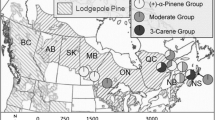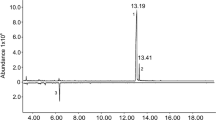Abstract
When both sexes of the bark beetle,Dendroctonus brevicomis LeConte, were exposed to vapors of myrcene from ponderosa pine, only the male produced (+)-ipsdienol. In the field, racemic ipsdienol significantly reduced the attraction of both sexes in flight to a mixture of myrcene and the aggregation pheromones,exo-brevicomin and frontalin. This suggests that ipsdienol may be involved in regulating colonization density ofD. brevicomis. The implications of the biosynthesis of various enantiomers of ipsdienol byD. brevicomis and the cohabitating bark beetles,Ips paraconfusus andI. pini, in relation to their behavioral responses are discussed in regard to reducing interspecific competition.
Similar content being viewed by others
References
Bedard, W.D., andBrowne, L.E. 1969. A delivery-trapping system for evaluating insect chemical attractants in nature.J. Econ. Entomol. 62:1202–1203.
Bedard, W.D., Tilden, P.E., Wood, D.L., Silverstein, R.M., Brownlee, R.G., andRodin, J.O. 1969. Western pine beetle: Field response to the sex pheromone and a synergistic host terpene, myrcene.Science 164:1284–1285.
Bedard, W.D., Silverstein, R.M., andWood, D.L. 1970. Bark beetle pheromones.Science 167:1638–1639.
Brand, J.M., Bracke, J.W., Markovetz, A.J., Wood, D.L., andBrowne, L.E. 1975. Production of verbenol pheromone by a bacterium isolated from bark beetles.Nature 254:136–137.
Browne, L.E. 1972. An emergence cage and refrigerated collector for wood-boring insects and their associates.J. Econ. Entomol. 65:1499–1501.
Byers, J. A. 1981. Pheromone biosynthesis in the bark beetle,Ips paraconfusus, during feeding or exposure to vapours of host plant precursors.Insect Biochem. 11:563–569.
Byers, J.A., andWood, D.L. 1980. Interspecific inhibition of the response of the bark beetles,Dendroctonus brevicomis andIps paraconfusus, to their pheromones in the field.J. Chem. Ecol. 6:149–164.
Byers, J.A., andWood, D.L. 1981a. Interspecific effects of pheromones on the attraction of the bark beetles,Dendroctonus brevicomis andIps paraconfusus in the laboratory.J. Chem. Ecol. 7:9–18.
Byers, J.A., andWood, D.L. 1981b. Antibiotic-induced inhibition of pheromone synthesis in a bark beetle.Science 213:763–764.
Byers, J.A., Wood, D.L., Browne, L.E., Fish, R.H., Piatek, B., andHendry, L.B. 1979. Relationship between a host plant compound, myrcene and pheromone production in the bark beetleIps paraconfusus.J. Insect Physiol. 25:477–482.
Hendry, L.B., Piatek, B., Browne, L.E., Wood, D.L., Byers, J.A., Fish, R.H., andHicks, R.A. 1980. In vivo conversion of a labelled host plant chemical to pheromones of the bark beetleIps paraconfusus.Nature 284:485.
Hughes, P.R. 1973.Dendroctonus: production of pheromones and related compounds in response to host monoterpenes.Z. Angew. Entomol. 73:294–312.
Hughes, P.R. 1974. Myrcene: A precursor of pheromones inIps beetles.J. Insect Physiol. 20:1271–1275.
Kinzer, G.W., Fentiman, A.F., Jr., Page, T.F., Jr., Foltz, R.L., Vité, J.P., andPitman, G.B. 1969. Bark beetle attractants and field bioassay of a new compound isolated fromDendroctonus.Nature 22:475–476.
Lehmann, E.L. 1975. Nonparametrics: Statistical Methods Based on Ranks. Holden-Day, San Francisco, 457 pp.
Light, D.M., andBirch, M.C. 1979. Inhibition of the attractive pheromone response inIps paraconfusus by (R)-(−)-ipsdienol.Naturwissenschaften 66:159–160.
Pitman, G.B. 1971.trans-Verbenol and alpha-pinene: Their utility in manipulation of the mountain pine beetle.J. Econ. Entomol. 64:426–430.
Pitman, G.B., Vite, J.P., Kinzer, G.W., andFentiman, A.F., Jr. 1969. Specificity of population-aggregating pheromones inDendroctonus.J. Insect Physiol. 15:363–366.
Plummer, E.L., Stewart, T.E., Byrne, K., Pearce, G.T., andSilverstein, R.M. 1976. Determination of the enantiomeric composition of several insect pheromone alcohols.J. Chem. Ecol. 2:307–331.
Renwick, J.A.A., Hughes, P.R., andKrull, I.S. 1976. Selective production ofcis andtrans-verbenol from (−) and (+) alpha-pinene by a bark beetle.Science 191:199–201.
Silverstein, R.M., Rodin, J.O., andWood, D.L. 1967. Methodology for isolation and identification of insect pheromones with reference to studies on California five-spinedIps.J. Econ. Entomol. 60:944–949.
Silverstein, R.M., Brownlee, R.G., Bellas, T.E., Wood, D.L., andBrowne, L.E. 1968. Brevicomin: Principal sex attractant in the frass of the female western pine beetle.Science 159:889–891.
Smith, R.H. 1964. Variation in the monoterpenes ofPinus ponderosa Laws.Science 143:1337–1338.
Smith, R.H.,Peloquin, R.L.,Jr., AndPassof, P.A. 1969. Local and regional variation in the monoterpenes of ponderosa pine xylem resin.USDA For. Serv. Res. Pap. PSW-56. 10 pp.
Wood, D.L., Browne, L.E., Silverstein, R.M., andRodin, J.O.1966. Sex pheromones of bark beetles—1. mass production, bioassay, source, and isolation of the sex pheromone ofIps confusus (LeC.).J. Insect Physiol. 12:523–536.
Wood, D.L., Browne, L.E., Ewing, B., Lindahl, K., Bedard, W.D., Tilden, P.E., Mori, K., Pitman, G.B., andHughes, P.R. 1976. Western pine beetle: Specificity among enantiomers of male and female components of an attractant pheromone.Science 192:896–898.
Author information
Authors and Affiliations
Additional information
Coleoptera: Scolytidae.
Rights and permissions
About this article
Cite this article
Byers, J.A. Male-specific conversion of the host plant compound, myrcene, to the pheromone, (+)-ipsdienol, in the bark beetle,Dendroctonus brevicomis . J Chem Ecol 8, 363–371 (1982). https://doi.org/10.1007/BF00987784
Received:
Revised:
Issue Date:
DOI: https://doi.org/10.1007/BF00987784




